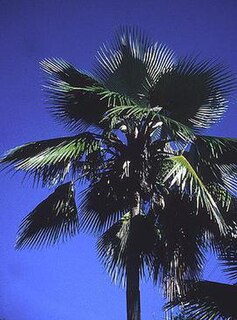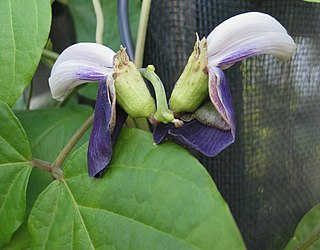
Pritchardia viscosa, the stickybud pritchardia or loʻulu, is an extremely rare endangered species of Pritchardia palm that is endemic to the Hawaiian island of Kauaʻi.
Spelaeorchestia koloana, the Kauaʻi cave amphipod or ʻuku noho ana in Hawaiian, is a cave-dwelling crustacean only found on the Hawaiian island of Kauaʻi. It is eyeless and measures 7–10 mm (0.28–0.39 in) long. It is only known from 10 populations, and eats decaying plant matter and other decomposing material.

Canavalia napaliensis, commonly known as the Mākaha Valley Jack-bean, is a species of flowering plant in the pea family, Fabaceae, that is endemic to Hawaii. It was previously more widespread in the archipelago and could be found in Oʻahu's Mākaha Valley, but is today restricted to northwestern Kauaʻi. This and other Hawaiian Canavalia are known there as ʻāwikiwiki.

The Kauai ʻakialoa was a Hawaiian honeycreeper in the subfamily Carduelinae of the family Fringillidae. It was endemic to the island of Kauai, Hawaii. It became extinct in the 20th century due to introduced avian disease and habitat loss. The Kauai ʻakialoa was about seven and a half inches in length and had a very long downcurved bill, which covered one third of its length. The adult males were bright olive-yellow on top and yellow on the bottom. The throat, breast, and sides of the body were olive-yellow. The females, however, were green-gray above and had a shorter bill.

Astelia waialealae is a rare species of plant in the Asteliaceae family that is endemic to the island of Kauaʻi of the state of Hawaii in United States. It inhabits montane bogs within the vicinity of the Alakaʻi Swamp on the island's central plateau. A. waialealae is threatened by habitat loss and habit disturbance by feral pigs; there are only about 26 plants remaining. It is a federally listed endangered species.
Melicope haupuensis is a species of tree in the family Rutaceae known by the common names Haupa Mountain melicope and Pacific pelea. It is endemic to the Hawaiian Islands, where it is known only from the island of Kauai. It is threatened by habitat loss. It is a federally listed endangered species of the United States. Like other Hawaiian Melicope, this species is known as alani.

Melicope knudsenii, commonly known as Olokele Valley melicope or Knudsen's melicope, is a species of flowering plant in the family Rutaceae, that is endemic to Hawaii. It inhabits montane mesic forests dominated by Acacia koa, Metrosideros polymorpha, and Dicranopteris linearis on Kauaʻi and East Maui (Auwahi). Associated plants include Syzygium sandwicensis, Cheirodendron trigynum, Myrsine lessertiana, Ilex anomala, Alphitonia ponderosa, Zanthoxylum dipetalum, Kadua terminalis, Pleomele aurea, Bobea spp., Tetraplasandra waimeae, Xylosma hawaiiense, Eurya sandwicensis, Psychotria mariniana, Melicope anisata, Melicope barbigera, Pouteria sandwicensis, Dodonaea viscosa, and Dianella sandwicensis. It is threatened by habitat loss. Like other Hawaiian Melicope, this species is known as alani. This is a federally listed endangered species of the United States.
Melicope pallida, the pale melicope, is a species of tree in the family Rutaceae. It is endemic to the Hawaiian Islands. It is threatened by habitat loss. It is a federally listed endangered species of the United States. Like other Hawaiian Melicope, this species is known as alani.

Melicope paniculata, the Lihue melicope, is a rare species of tree in the family Rutaceae. It is endemic to the Hawaiian Islands. Like other Hawaiian Melicope, this species is known as alani.
Melicope puberula, the hairy melicope, is a species of plant in the family Rutaceae. It is endemic to the Hawaiian Islands. Like other Hawaiian Melicope, this species is known as alani. In 2010 it was added to the endangered species list of the United States.
Myrsine knudsenii, the Kokee colicwood, is a species of tree in the primrose family. It is endemic to the island of Kauai in Hawaii. It is threatened by habitat loss.
Myrsine mezii, the Hanapepe River colicwood, is a species of tree in the primrose family. It is endemic to the island of Kauai in Hawaii. It is threatened by habitat loss. It is a federally listed endangered species of the United States.

Pittosporum napaliense, the royal cheesewood, is a species of plant in the Pittosporaceae family. It is endemic to Hawaii, where it is known only from northwestern Kauai. It became a federally listed endangered species in 2010.
Psychotria grandiflora, the largeflower wild coffee, large-flowered balsamo or kopiko, is a species of plant in the family Rubiaceae endemic to the island of Kauai in the Hawaiian Islands. It grows in rainforest habitat. There are ten small populations remaining, with a total of no more than 30 individuals. This plant was federally listed as an endangered species of the United States in 2010.
Psychotria greenwelliae, the Kauai wild coffee, is a species of plant in the family Rubiaceae. It is endemic to the islands of Kauai and Oahu in Hawaii. It is threatened by habitat loss.
Pteralyxia kauaiensis, also called Kaulu or Kauaʻi pteralyxia, is a species of plant in the family Apocynaceae. It is endemic to the island of Kauaʻi in the Hawaiian Islands. It is threatened by habitat loss and degradation. There are no more than 1000 individuals remaining. It is federally listed as an endangered species of the United States.
Cyanea eleeleensis was a rare species of flowering plant in the bellflower family known by the common name Eleele cyanea. It was endemic to Kauai, where it has been declared extinct. It was federally listed as a critically endangered species of the United States in 2010. Like other Cyanea it is known as haha in Hawaiian.

Delissea rhytidosperma, is known by the common names Kauai delissea, Kauai leechleaf delissea, and leechleaf delissea. It is a rare species of flowering plant in the bellflower family, that is endemic to Hawaii where it is known only from the island of Kauai. It is critically endangered or extinct in the wild.
Melicope rostrata, synonym Platydesma rostrata, is a rare species of flowering plant in the citrus family, known by the common name pilo kea lau li'i. It is endemic to Hawaii, where there are only about 100 individuals remaining on island of Kauai. It was federally listed as an endangered species of the United States in 2010.
Poa mannii is a rare species of grass known by the common names Mann's bluegrass and Olokele Gulch bluegrass. It is endemic to Hawaii, where it is limited to the island of Kauai. It is threatened by the loss and modification of its habitat. It is a federally listed endangered species of the United States.








